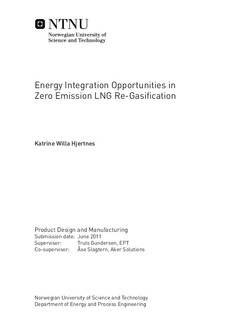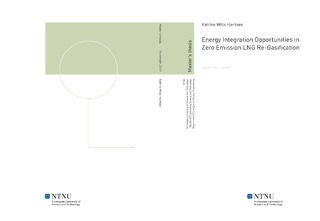| dc.description.abstract | Due to the increasing demand for LNG, more environmental friendly regasification solutions are of interest. Aker Solutions has developed a concept for zero emission regasification of LNG, where the regasification train is heat integrated with an oxy-fuel power and steam plant. The oxy-fuel combustor burns part of the send-out gas in an oxygen enriched environment. The flue gas produced is CO2 rich, making CO2 capture feasible. 95mol% pure oxygen is produced by cryogenic distillation in an ASU. Today, oxy-fuel combustion is not economical feasible, mainly due to the significant power demand in the ASU and the CO2 Compression and Purification Unit (CPU). This thesis investigates opportunities of reducing the power consumption in the plant. Pinch analysis is used to evaluate the heat integration in the Aker Solutions concept. Simulation models are created in Aspen Hysys to investigate possibilities of integrating the ASU with the power and steam plant, and to find the impact of changing the oxygen purity. In addition the use of membranes to separate air is discussed. The heat integration was evaluated in terms of sequence of the pair matches, and placement of Heat Transfer Fluids (HTFs). The sequence of the streams was found acceptable. However, changing the HTF in LNG heater 2 and 3 from MEG/Water to Methanol could be beneficial. The freezing point of Methanol is lower than that of MEG/Water; hence the HTF can be shifted to a lower temperature. Because LNG has a higher h-value than the hot streams, ∆T between the LNG and the HTF should be lower than that of the hot fluid and the HTF. If the oxygen purity was set to 90mol%, the load of the CO2 CPU and the condenser duty of the N2/CO2 distillation were increased by 10% and 65% respectively. If the purity was increased to 97mol% the opposite results were obtained. Although increasing the purity leads to savings in the CO2 CPU, this unit only accounts for a small part of the overall power consumption compared to the ASU, hence the impact on the ASU is of greater concern. For the ASU, decreasing the purity would lead to some energy savings. However, the required equipment size of the unit would increase. If the purity is increased, the separation of Argon is required in the distillation column, thus a significant increase in energy of separation is experienced. In addition the capital expenses of the ASU are increased, due to implementation of a supplementary distillation column. Based on the previous facts, it was recommended to keep the oxygen purity at 95mol%. If integrating the ASU, cryogenic LNG should be used to cool the air upstream and downstream the air compressor. Results from Hysys showed that this would lead to 18 % reduction in external utility consumptions. In addition the compressor work of the ASU would be decrease by 14%, and the yield of the LP turbine would increase with 2MW. Today, membranes are not capable of producing large quantities of oxygen. However, there exist some membranes with great potential. The most promising membranes are found to be MIECs with a perovskite structure, especially Ba0.5Sr0.5Co0.8Fe0.2O3-δ. At 800ºC the oxygen flux of these membranes are found to be approximately 1.56∙10-6 mol/scm2, and the oxygen purity obtained is above 99mol%. The thickness of one of these membrane were found to be 1.8mm, hence more than 1∙109 membranes are required to produce enough oxygen for the oxy-combustion plant. Although these membranes have a great potential, they need to be further evolved before implemented to oxy-fuel power plants. | nb_NO |

